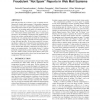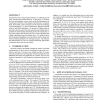10 search results - page 2 / 2 » Introducing the Webb Spam Corpus: Using Email Spam to Identi... |
CEAS
2011
Springer
12 years 4 months ago
2011
Springer
Web mail providers rely on users to “vote” to quickly and collaboratively identify spam messages. Unfortunately, spammers have begun to use bots to control large collections o...
CORR
2000
Springer
13 years 4 months ago
2000
Springer
We investigate the performance of two machine learning algorithms in the context of antispam filtering. The increasing volume of unsolicited bulk e-mail (spam) has generated a nee...
CEAS
2008
Springer
13 years 6 months ago
2008
Springer
Social networking communities have become an important communications platform, but the popularity of these communities has also made them targets for a new breed of social spamme...
CEAS
2007
Springer
13 years 11 months ago
2007
Springer
Email has become an integral and sometimes overwhelming part of users’ personal and professional lives. In this paper, we measure the flow and frequency of user email toward th...
CNIS
2006
13 years 6 months ago
2006
Almost all current anti spam measures are reactive, filtering being the most common. But to react means always to be one step behind. Reaction requires to predict the next action ...


